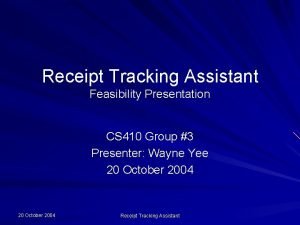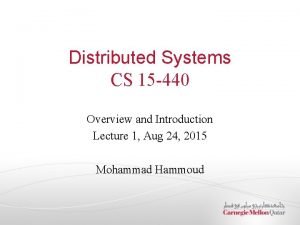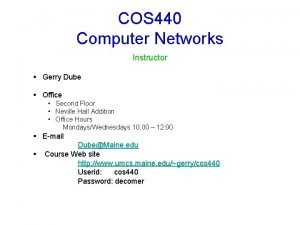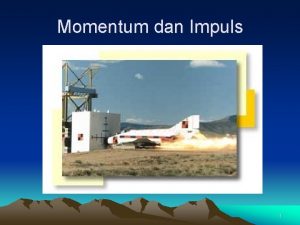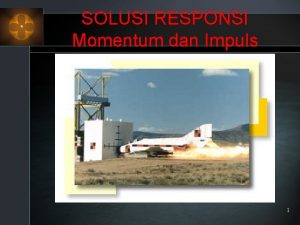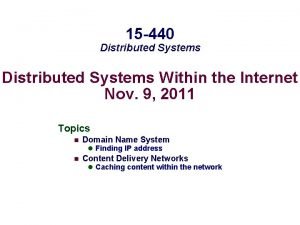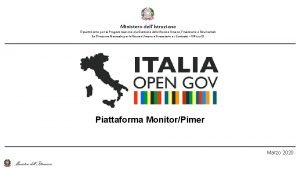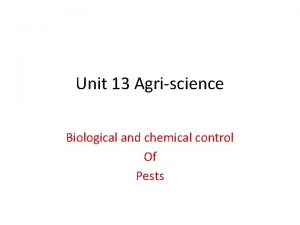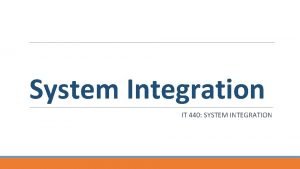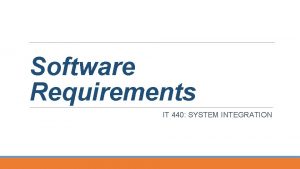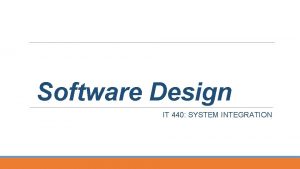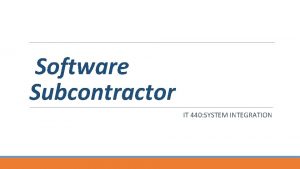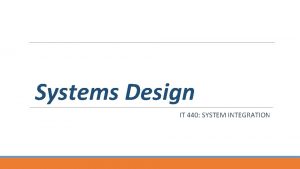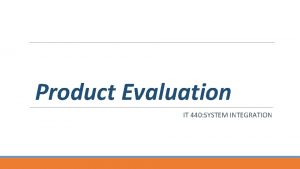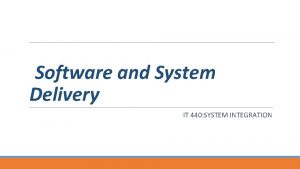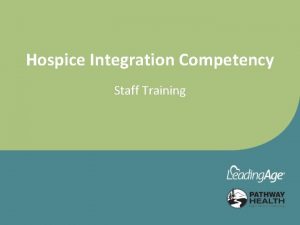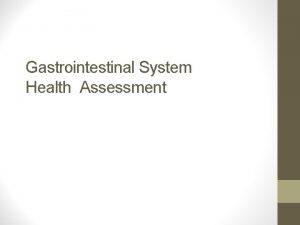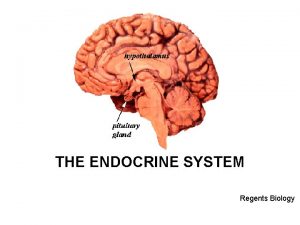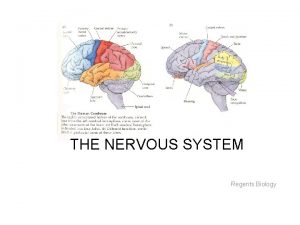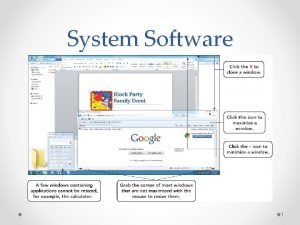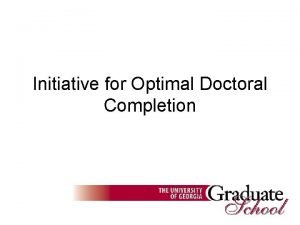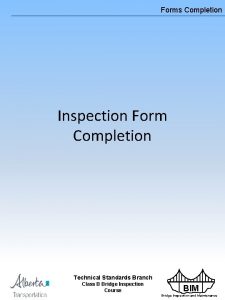Software Integration IT 440 SYSTEM INTEGRATION Upon completion



















- Slides: 19

Software Integration IT 440: SYSTEM INTEGRATION

Upon completion of this week’s activities, you will be able to: ✓Discuss how the methods for software integration provide required steps to be con ducted for integration and checkout of informal software engineering builds. ✓Explain why the software design/development team and test engineers need to develop a strategy for planning, design, execution, data collection, and test evaluation. ✓Identify the software integration activities, which are informal and flexible for software checkout to prepare for the software and systems integration phase of the work product.

SOFTWARE INTEGRATION Methods: provide required steps to be conducted for integration and checkout of informal software engineering builds. Activities: informal and flexible for software checkout to prepare for the software and systems integration phase.

SOFTWARE INTEGRATION STRATEGY Purpose: describes the steps to be conducted as part of the implementation of software to start integration activities. Importance: flexibility with an approach that to show change.

PLANNING CHARACTERISTICS ✓Effectively conducted technical reviews ✓Differentiated integration techniques and software approaches ✓ Required involvement of software designers from start to finish

APPROACH TO SOFTWARE INTEGRATION Planned in advance as the start for effective software integration. • accommodates lower level integration to verify software code development that has been implemented correctly and major system functional expectations met. • provides guidance software design/development and test teams to reach milestone expectations. • The steps occur many times each time deadlines occur. • Measurement problems resolved early in schedules.

SOFTWARE INTEGRATION TESTING Concept: to uncover errors, troubleshoot, and fix problems that occur during a test. Purpose: having plans and procedures in place ensure that testing strategies are not wasted time during integration.

“BAM THEORY” APPROACH Purpose: to attempt nonscheduled software integration and testing. Three step approach: 1. Software test plans, procedures, or internal work instructions are ready to support integration 2. Software integration is ready for testing to be conducted and performed by all team members 3. Control must be maintained between multiple tests running at the same time (lack of control can cause chaos)

DEVELOPMENT FACILITY Purpose: established early on in software design/development phases for software integration activities. Use: to prepare software prior to delivery to a software systems integration facility (S/SIF). Overview: includes geographic locations, facilities used, and secure areas. Requirement: equipment furnished by customer, software, services, documentation, data, facilities, and a detailed schedule highlighting when needed items are included. • Additional required resources: plans for obtaining the resources, dates needed, and availability of each resource item.

SOFTWARE OPERATIONS Intrinsic adaptation for software operations include: • parameter based initialization data • settings selected/entered by designer/developer • test teams during operations of the software • systems retained for other test integration purposes.

SOFTWARE DESIGN/DEVELOPMENT ENVIRONMENT REQUIREMENTS • Plans must ensure each element of an environment performs to intended functions. • Plans provide requirements for test environments to perform software testing, including integration, troubleshooting, and checkout • ensure each element of the test environment performs intended functions.

SOFTWARE CONFIGURATION Software Configuration Identifications Purpose: ensures configuration control. Configured Baseline Purpose: identifies the development life cycle specifically, functional and allocated work product baselines. • Configured baselines are defined by unique software documentation and media software.

SOFTWARE INTEGRATION SETUP • Involves planning with program and project managers to coordinate with the facility operations manager. • Allocated resources (i. e. , computers, workstations, and hardware units) provided to the software designer/developer and test teams to conduct informal integration testing. • Software engineering builds and loading into hardware units are performed by build engineers.

INTEGRATION TEST System integration tests are conducted inside programs and project integration facilities. • Includes verification steps: ensures tests provide a check of the capabilities of software and hardware units. • Repeated numerous times: ensures all integration test problems are resolved, performance is accomplished early in the defined system, and the system is working to software requirements.

INSTALLATION PLANS AND PROCEDURES Purpose: defines systems’ specification requirements. • Software integration test plans: covers the testing of requirements and verification methods conducted in the DF. • Specific integration test plans: consist of checkout activities to ensure system utilization. • Integration testing environment: provides necessary steps to be followed, data collected, and analysis solutions are used or implemented • Installation test plans: peer reviewed and approved for release by program and project managers • prepares for the start of software integration testing.

SOFTWARE INTEGRATION LOG Purpose: provides a view of the day to day operations for the design and test teams using hardware units for integration and checkout. Use: supports operational setup activities. • Software design teams have the ability to fix/debug problems and work with test teams • Ensures plans and procedures will be ready for release to support formal test phases

INTEGRATION VERIFICATION AND VALIDATION Verification: set of tasks to ensure correct implementation techniques are in place and product integrated correctly. Validation: ensures the correct work product is the correct product to validate.

QUALITY TEAM ROLE ✓ Performs technical reviews ✓Audits configuration management ✓Software integration progression monitoring ✓Reviews plans, procedures, and documentation ✓Tests qualification and acceptance ✓Witnesses implemented plans/procedures during integration/testing

CONFIGURATION REVIEWS AND AUDITS Purpose: ensures all elements of software configurations are developed and in control during software integration and test activities. Key Timing: before entering into formal software and systems integration.
 Area code 440 location
Area code 440 location Polylite 440-m850
Polylite 440-m850 15-440
15-440 Cos440
Cos440 Xenotest 440
Xenotest 440 Sebuah gerbong kereta api mempunyai massa 10.000 kg
Sebuah gerbong kereta api mempunyai massa 10.000 kg 25-3/440
25-3/440 Cpt ai
Cpt ai Bola dengan massa 0 440 kg yang bergerak ke timur
Bola dengan massa 0 440 kg yang bergerak ke timur 15-440 cmu
15-440 cmu 25-3/440
25-3/440 Spravac
Spravac Ensc 440
Ensc 440 Section 17-4 patterns of evolution pages 435-440 answers
Section 17-4 patterns of evolution pages 435-440 answers Ensc 440
Ensc 440 Piattaforma pimer monitor
Piattaforma pimer monitor Fin 440
Fin 440 Ffsst
Ffsst Well completion
Well completion Agriscience unit 13 completion answers
Agriscience unit 13 completion answers
